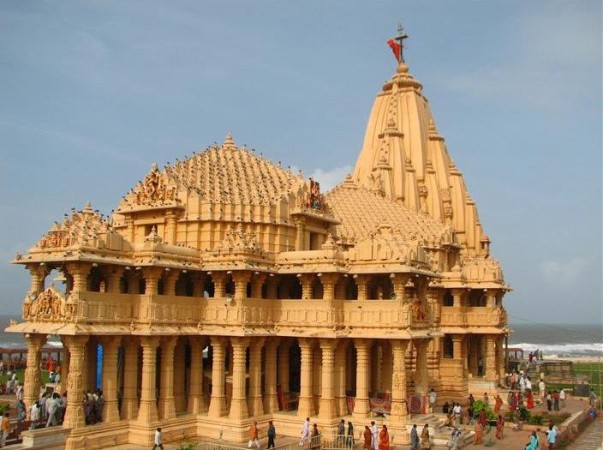
The Somnath Temple, situated in the Veraval port of the Saurashtra region in Gujarat, holds significant importance as the first Jyotirlinga among the 12 Jyotirlingas of Lord Shiva. Its grandeur attracts millions of devotees from India and abroad, including tourists of various religions. However, the issue of restricting entry to only Hindus has been a subject of controversy. In this article, we delve into the rich history of the Somnath Temple, which has witnessed destruction and reconstruction multiple times over the ages.
Ancient Origins and Early Reconstructions:
Historical records indicate that the Somnath Temple existed even before the time of Christ. It was rebuilt for the second time in 649 AD by the Maitrik kings of Valabhi. However, its fortunes took a dark turn when Al Junaid, the Muslim governor of Sindh, demolished the temple in 725 AD. It was reconstructed once again in 815 AD by King Nagabhatta of the Pratihara dynasty.
Destruction by Mahmud Ghaznavi:
One of the most infamous episodes in the temple's history occurred in 1024 when Mahmud Ghaznavi, a ruler from Ghazni, attacked the Somnath Temple with an army of 5,000 soldiers. He plundered its treasures, looted gold, silver, diamonds, and jewels, and attempted to break the sacred Shivling inside. Despite his efforts, the Shivling remained unscathed. In frustration, Ghaznavi set fire to the surrounding area and killed numerous unarmed worshipers and villagers who sought to protect the temple.
Reconstruction by Hindu Kings and Marathas:
Following the devastation caused by Mahmud Ghaznavi, King Bhimdev of Gujarat and King Bhoj of Malwa took on the responsibility of rebuilding the temple. Later, in 1093, Siddharaj Jai Singh contributed to its construction, and in 1168, Vijayeshwar Kumarpal and King Khangar of Saurashtra contributed to the beautification of the Somnath Temple. However, the temple faced further destruction during the time of the Delhi Sultanate and Aurangzeb, who targeted the temple in 1297, 1665, and 1706 AD.
Resilience in Independent India:
The reconstruction of the Somnath Temple became a significant project for independent India. Sardar Vallabhbhai Patel, known as the Iron Man of India, spearheaded the efforts to rebuild the temple in 1951 after the country gained independence. Sardar Patel sought the support of Mahatma Gandhi, who suggested raising funds from the public for the reconstruction. Upon completion, the temple was dedicated to the nation by President Shankar Dayal Sharma on 1st December 1995.
Somnath Temple: A Marvel of Architecture:
The reconstruction of the Somnath Temple is renowned as one of the most prestigious projects in independent India. The Sompura family, experts in designing traditional Indian Nagara style temples, undertook the construction. Notably, the temple's unique architectural feature was a Shivling seemingly suspended in the air, which experts attributed to the power of a magnet.
The Somnath Temple stands as a symbol of resilience, having been destroyed and rebuilt multiple times throughout history. Its reconstruction in independent India under the leadership of Sardar Patel represents the unwavering spirit of the nation. Despite its tumultuous past, the Somnath Temple continues to draw devotees and visitors from all walks of life, fostering a sense of unity and spiritual reverence.
Muharram 2023: Jammu govt postpones ‘Ashura’ holiday; See new date
Sindhi Religion: A Journey of Cultural and Spiritual Traditions
If you are going on the Kailash Mansarovar Yatra, do not forget to visit these places as well